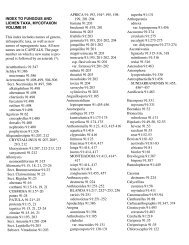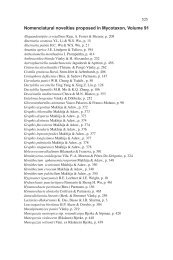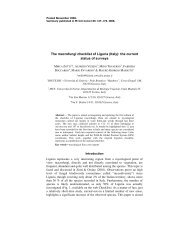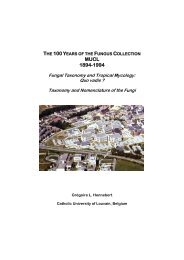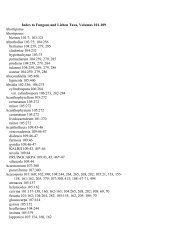download full review [pdf] - Mycotaxon
download full review [pdf] - Mycotaxon
download full review [pdf] - Mycotaxon
You also want an ePaper? Increase the reach of your titles
YUMPU automatically turns print PDFs into web optimized ePapers that Google loves.
<strong>Mycotaxon</strong> 110 Book Reviews ... 519<br />
given the pace of discovery in the genus. Inevitably, many recently described<br />
Phytophthora species are missing, and updated editions or even web-based<br />
supplements would thus be welcome. It is also noted that the SSCP method<br />
for analysing the sequence variation in the ITS regions has limitations.<br />
Improved availability and reductions in price are turning laboratories to DNA<br />
sequencing as the method of choice. Sequencing provides the ultimate baseby-base<br />
resolution, and is pretty straightforward and rapid to run compared<br />
to restriction enzyme digestion or SSCP. Matching SSCP fingerprints is also<br />
challenging; ideally the fingerprint profile of the unknown isolate should be run<br />
directly alongside that of suitable reference strains, which may not be available in<br />
the user’s laboratory. By comparison, a DNA sequence may be readily matched<br />
to the very large databases via BLAST sequence similarity methods. Lastly,<br />
there are clearly problematic taxa where no key or single method will provide<br />
a definitive identity. A range of undescribed taxa within ITS clade 6 have, for<br />
example, been reported. Many of these are considered sterile and a key that<br />
depends upon morphological features of the sexual structures will obviously<br />
fail to identify such taxa. Sequence variation within defined morphospecies<br />
will also be a problem as acknowledged in P. cryptogea, P. megasperma, and<br />
P. citricola. Some of these taxonomic inconsistencies have been, or are in the<br />
process of being, unraveled and any new editions will need to acknowledge this<br />
progress.<br />
Other quibbles: Descriptions or images of the colony morphology on<br />
standard growth media and reference to the ITS sequences (where known)<br />
would have been helpful. The authors assert that the pictures are simply to<br />
“show the morphology . . . with no attempt to show the fine details”, but it is<br />
a pity that the quality of the micrographs is not higher. Lastly, it is surprising<br />
that the micrographs of “definitive morphological characters” do not include<br />
examples of amphigynous and paragynous antheridia.<br />
David E. L. Cooke<br />
Plant Pathology Programme, Scottish Crop Research Institute,<br />
Invergowrie, Dundee DD2 5DA. UK<br />
Basidiomycetes<br />
Funga Nordica: agaricoid, boletoid and cyphelloid genera. Edited by Henning<br />
Knudsen & Jan Vesterholt. 2008. Nordsvamp, c/o Botanical Museum, Gothersgade<br />
130, DK-1123 Copenhagen, Denmark. Pp. 965, figs, DVD. ISBN 978-87-983961-3-0.<br />
Price 99-119 €, £ 75-106, US $ 148-176.<br />
This work is surely destined to become the work for the identification of<br />
northern European mushrooms for decades to come. It represents a herculean<br />
effort involving 41 mycologists from 16 countries and covers 2675 species from


![download full review [pdf] - Mycotaxon](https://img.yumpu.com/5381692/11/500x640/download-full-review-pdf-mycotaxon.jpg)
